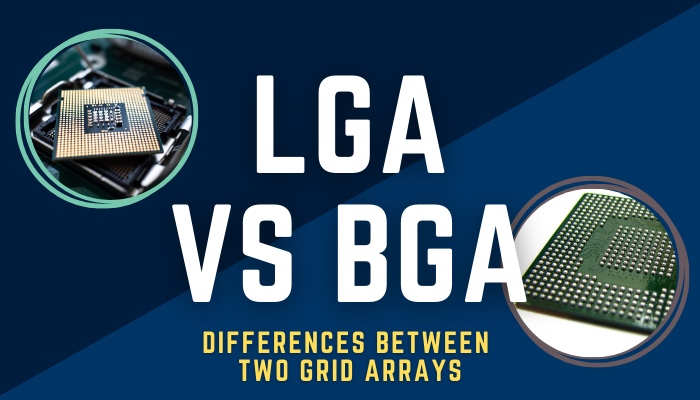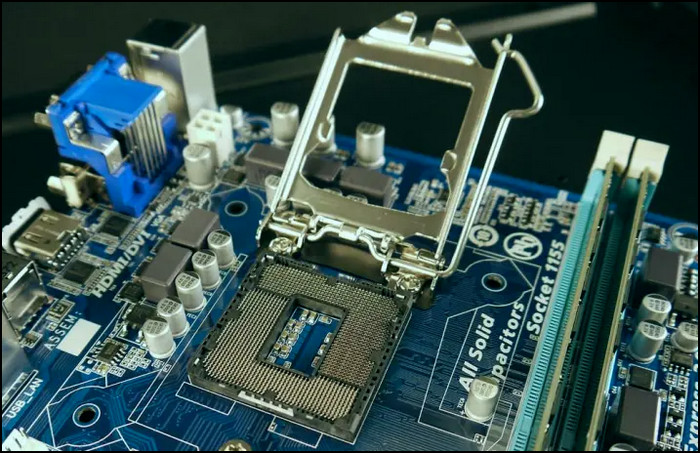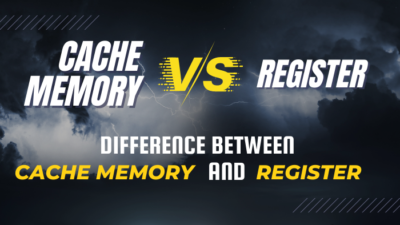CPU and motherboard are the two most crucial components of a computer, and the socket works as the bridge between them.
Land Grid Array (LGA) and Ball Grid Array (BGA), both are surface-mounted technology and define the connection method in the middle of the CPU and motherboard socket. However, there are several differences between LGA and BGA, and I’ll describe all of them in this article.
However, there are several differences between LGA and BGA, and I’ll describe all of them in this article.
So, let’s start.
What is LGA?
The Land Grid Array or LGA is a surface-mounted packaging for an integrated circuit that has pins on the socket instead of the IC. The LGA is electronically connected to the printed circuit board by a socket or soldering directly to the PCB.  The CPU has no pins on its surface, rather it contains metal pads on the bottom side of the processor. The pins on the socket and metal pads on the processor contact each other and establish a connection.
The CPU has no pins on its surface, rather it contains metal pads on the bottom side of the processor. The pins on the socket and metal pads on the processor contact each other and establish a connection.
LGA sockets have rectangular contact grids—also known as land—on their underside to connect the processor easily.
The LGA sockets are widely used in Intel processors. But, there are different types of LGAs, and they change depending on the processor generation.
Here is the list of LGA sockets uses in the Intel processor:
- LGA1151 socket – 6th, 7th, 8th, and 9th Gen Intel processor.
- LGA1200 socket – 10th & 11th Gen Intel CPU.
- LGA1700 socket – 12th & 13th Gen Intel processor.
The number beside the name defines the total pin amount in the LGA socket. The CPU also has the same number of contact points on its surface.
Also, check our detailed comparison of LGA and PGA sockets in a different article.
Generally, AMD processors use PGA sockets to connect CPUs. But there are a couple of AMD processors that use LGA sockets to place the CPU.
The following list will provide the LGA sockets used in the AMD processor:
- LGA Socket TR4 – AMD Ryzen Threadripper
- LGA Socket sTRX4 – AMD Ryzen Threadripper (3000 series)
- LGA Socket AM4 – Ryzen 3, Ryzen 5, Ryzen 7, Ryzen 9.
- LGA Socket SP3 – AMD Epyc
- LGA Socket AM5 – AMD Ryzen 7000 series
The LGA is a powerful socket and has many advantages over the PGA and BGA socket. However, it’s not completely free from drawbacks.
Read the table below to see the pros and cons of LGA:
- »The size is very compact and space efficient.
- »Pins sizes are small and capable of fitting many of them.
- »It’s very reliable due to the pins being attached to the PCB.
- »It consumes a lot of power.
Mainly, the LGA sockets are used in the desktop computer. In addition, it has an upper hand in most of the sectors and the CPU is very easy to replace in an LGA socket.
Also, it’s necessary to use a good CPU cooler with Intel LGA 1200 socket to keep your CPU in a good condition.
What is BGA?
Ball Grid Array or BGA is a surface-mounted packaging for the integrated circuit (IC) that is used to permanently mount the processor. The BGA package has small balls on the surface, arranged in rows and columns to connect and establish a connection with the CPU.
Just like the PCB surface, the back of the CPU also contains small balls. The balls of each surface come in contact to create a connection.  To assemble the processor, the CPU has to be placed over the PCB and the BGAs are heated by using infrared heaters or the inside of a reflow oven. It melts the solder and secures the processor to the printed circuit board.
To assemble the processor, the CPU has to be placed over the PCB and the BGAs are heated by using infrared heaters or the inside of a reflow oven. It melts the solder and secures the processor to the printed circuit board.
If you are looking to sell off your processor, you need to make sure that the CPU is shipped off safely. Check our separate article and become a pro at packaging your CPU.
BGA sockets are smaller and mostly used in laptops, notebooks, and mobile phones. The package has a high density of connections that helps to improve performance.
There are different variants of BGA sockets, CABGA, CTBGA, CVBGA, FBGA, etc. For example, BGA 437, BGA 441, and GC-BGA 518.
Similarly to the LGA socket, the digit at the end of the BGA socket name indicates the number of contacts it bears.
The BGA socket is older and outdated compared to LGA, and there are both pros and cons to using a BGA socket.
Follow the table below to learn the advantage and disadvantage of BGA:
- »It’s small in size and space efficient.
- »It rarely overheats.
- »BGA has low impedance due to the short connection path.
- »It has fantastic thermal and mechanical properties.
- »Soldering is difficult.
- »The repair process is very hard
- »It has limited application because it requires a multi-layer circuit board.
If you want to learn the differences between LGA and BGA, consider reading the following passage.
If you have damaged your CPU pins somehow, this can come as a big shocker for you. Thankfully you can replace the CPU pins. Check our separate article where we lay out the details for this.
What is the Difference Between LGA & BGA
Land Grid Array (LGA) and Ball Grid Array (BGA) have differences in connection type, socket volume, replacement possibilities, thermal conductivity, and in power consumption. Also, the field to use the LGA and BGA sockets is separate from each other.
To understand the dissimilarity between LGA and BGA, I’ve provided a table below.
Here are the differences between LGA and BGA:
| Comparison Area | LGA | BGA |
|---|---|---|
| Name | Land Grid Array | Ball Grid Array |
| Connection Type | Pins | Solder balls |
| Volume | Bigger than BGA | Smaller than LGA |
| Scope or Use | Desktop PC | Laptop, Mobile |
| Replacement Performance | Reusable | One time use |
| Thermal Conductivity | Large and better than BGA | Smaller than LGA |
| Power Consumption | More than BGA | Less than LGA |
| Installation | Simple | Difficult |
The above comparison will help to differentiate the Land Grid Array and Ball Grid Array sockets and assist you when purchasing a motherboard.
LGA Vs BGA: Which is Better?
Depending on the facilities and efficiency, Land Grid Array (LGA) is better than Ball Grid Array (BGA) socket. LGA has a better connection method, easy to install, and is replaceable. Also, the LGA socket is very reliable and suitable to use in computers.
But based on the preferences and requirements, the choice can be different. In today’s laptop, an LGA-based laptop is hard to find.
Due to portability, BGA is widely used in laptops, mobile, routers, and other devices. While LGA is the best among the sockets for a desktop PC, and relatively newer than the BGA socket.
It’s reliable and very easy to fix the bent pin in the LGA socket. For this vast amount of advantages, AMD has started to provide LGA support to their processor along with Intel.
If you are building a desktop PC, an LGA-based motherboard and CPU would be your best bet.
Frequently Asked Questions
What are BGA and LGA?
BGA is Ball Grid Array that connects using soldering balls, and LGA is Land Grid Array that establishes a connection using pins.
How many types of sockets are there?
The computer motherboard comes with three different sockets. They are LGA, PGA and BGA. LGA is most popular among all the socket.
Why do laptops use BGA?
BGA chips are easier to align and install to the printed circuit board in a laptop compared to PGA and LGA.
Wrapping Up
LGA & BGA are two fantastic integrated circuits, and provides a connection between your CPU and motherboard. Regardless of their disadvantages, there are lots of similarities and advantages which work perfectly in different cases.
This article has explained LGA, BGA, and their differences to give you a proper idea about them.
Don’t forget to share your thoughts in the comment box below, and I’ll catch you at the next one.
Goodbye!




